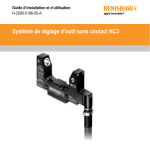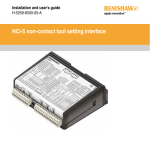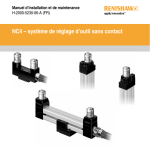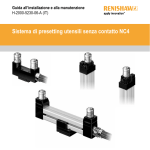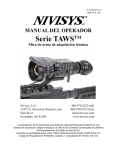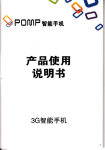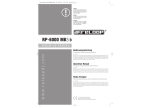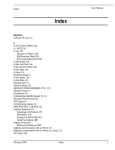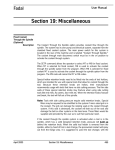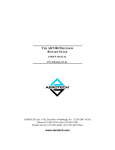Download NC3 non-contact tool setting system
Transcript
Installation and user’s guide H-2000-5196-05-A NC3 non-contact tool setting system © 2002–2011 Renishaw plc. All rights reserved. Trademarks This document may not be copied or reproduced in whole or in part, or transferred to any other media or language, by any means, without the prior written permission of Renishaw. RENISHAW® and the probe emblem used in the RENISHAW logo are registered trademarks of Renishaw plc in the UK and other countries. The publication of material within this document does not imply freedom from the patent rights of Renishaw plc. All other brand names and product names used in this document are trade names, service marks, trademarks, or registered trademarks of their respective owners. Disclaimer Warranty RENISHAW HAS MADE CONSIDERABLE EFFORTS TO ENSURE THE CONTENT OF THIS DOCUMENT IS CORRECT AT THE DATE OF PUBLICATION BUT MAKES NO WARRANTIES OR REPRESENTATIONS REGARDING THE CONTENT. RENISHAW EXCLUDES LIABILITY, HOWSOEVER ARISING, FOR ANY INACCURACIES IN THIS DOCUMENT. Equipment requiring attention under warranty must be returned to your supplier. No claims will be considered where equipment has been incorrectly installed or misused, or where repairs or adjustments have been attempted by unauthorised persons. Prior consent must be obtained in instances where Renishaw equipment is to be substituted or omitted. Failure to comply with this requirement will invalidate the warranty. apply innovation is a trademark of Renishaw plc. Patents Features of the NC3 non-contact tool setting system are subject to the following patents and patent applications: Renishaw part no: H-2000-5196-05-A First issued: Revised: 09 2002 02 2003 08 2003 03 2004 12 2011 CN1187572 CN1202403 CN1660541 EP 1050368 EP 1144944 EP 1208351 EP 1506073 EP 1562020 JP 2003-521,681 JP 2003-524,154 JP 4521094 KR 0746932 KR 0810975 TW NI-153868 TW NI-178572 US 6,496,273 US 6,635,894 US 6,878,953 US 6643562 US 7,053,392 Contents 1 Preliminary information...................................... 2 Specification.................................................... 16 Warnings and cautions...................................... 3 Alignment......................................................... 17 Warnings..................................................... 3 Achievable set-up tolerances.................... 17 Caution – Laser safety................................ 3 Aligning the NC3....................................... 17 Laser warning labels and location of laser aperture............................................................. 4 NCi-5 interface................................................. 19 Introduction........................................................ 5 Applying electrical power.......................... 20 Dimensions and mounting dimensions.............. 6 NC3 to NCi-5 wiring.................................. 21 Installation......................................................... 7 Maintenance.................................................... 22 Base and side mounting options................. 7 Introduction............................................... 22 Angled mounting option.............................. 8 Guidelines................................................. 22 Mounting the unit......................................... 9 Cleaning.................................................... 22 Air supply.................................................. 10 Air regulator unit........................................ 25 Conduit adaptor and conduit..................... 13 Parts list........................................................... 28 General............................................................ 15 Status LED................................................ 15 Recommended feedrates.......................... 15 Software routines...................................... 15 Installation................................................. 19 2 Preliminary information EC DECLARATION OF CONFORMITY c Renishaw plc declares that the NC3 non-contact tool setting probe complies with the applicable standards and regulations. Contact Renishaw plc at www.renishaw.com/nc3 for the full EC declaration of conformity. FCC Information to user (FCC Section 15.19) This device complies with Part 15 of the FCC rules. Operation is subject to the following conditions: 1. This device may not cause harmful interference. 2. This device must accept any interference received, including interference that may cause undesired operation. WEEE DIRECTIVE Information to user (FCC Section 15.105) The use of this symbol on Renishaw products and/or accompanying documentation indicates that the product should not be mixed with general household waste upon disposal. It is the responsibility of the end user to dispose of this product at a designated collection point for waste electrical and electronic equipment (WEEE) to enable reuse or recycling. Correct disposal of this product will help to save valuable resources and prevent potential negative effects on the environment. For more information, please contact your local waste disposal service or Renishaw distributor. This equipment has been tested and found to comply with the limits for a Class A digital device, pursuant to part 15 of the FCC Rules. These limits are designed to provide reasonable protection against harmful interference when the equipment is operated in a commercial environment. This equipment generates, uses and can radiate radio frequency energy and, if not installed and used in accordance with this installation guide, may cause harmful interference to radio communications. Operation of this equipment in a residential area is likely to cause harmful interference, in which case you will be required to correct the interference at your own expense. Information to user (FCC Section 15.21) The user is cautioned that any changes or modifications not expressly approved by Renishaw plc or authorised representative could void the user’s authority to operate the equipment. Warnings and cautions Warnings ! Use of controls or adjustments or performance of procedures other than those specified within this publication may result in hazardous radiation exposure. Switch off the power supply before carrying out maintenance on the NC3 unit. Caution – Laser safety The laser used in the Renishaw NC3 non-contact tool setting system emits continuous visible red light at a wavelength of 670 nm and has a maximum power output of less than 1 mW. The NC3 is classified as a Class 2 laser product as defined by the International standard IEC / EN 60825‑1:2007. The product complies with 21CFR 1040.10 and 1040.11 except for deviations pursuant to Laser Notice No. 50 dated June 24, 2007. 3 The International standard IEC / EN 60825‑1 directs to attach a laser warning label and explanatory label. A warning label and explanatory label are permanently fixed to each side of the transmitter housing (see the next page for details). An adhesive explanatory label is provided for attachment outside the machine. Safety rules Do not stare directly into the laser beam. The beam may be viewed safely from the side. Avoid visual exposure to the beam with optical appliances. Ensure that the beam is not reflected into the eyes of another person via a mirror or other reflective surface. Do not expose skin to the laser beam for longer than is absolutely essential. Instruct all operators about the hazards of direct eye contact, or long skin exposure, with the laser. Attach the laser warning label supplied in an easily visible location on the machine. 4 Laser warning labels and location of laser aperture Laser aperture Label B Label A Label B Label A Warning label Explanatory label Except for deviations pursuant to Laser Notice No. 50 dated June 24 2007 Introduction Introduction The NC3 is a laser-based non-contact tool setting system that provides high-speed/high-precision measurement of cutting tools on a machining centre under normal operating conditions. As a tool moves through the laser beam, the system detects when the beam is broken. Output signals sent to the controller allow the presence of a tool and the position of the tip (broken tool detection) to be established. 5 6 Dimensions and mounting dimensions 13 (0.51) 26 (1.02) 135 (5.31) 29 (1.14) 38 (1.50) 80 (3.15) Status LED for indication only 77 (3.03) 25 (0.98) 34 (1.34) 59.5 (2.34) 67.5 (2.66) 9 (0.35) ±2° 35.5 (1.40) 32.5 (1.28) Ø17 (0.67) 62 (2.44) 47 (1.85) 31 (1.22) centre of beam 18 (0.71) 21.75 (0.86) 4.25 (0.17) 13 (0.51) 26 (1.02) Dimensions in mm (in) Installation – base and side mounting options 7 M4 screws (supplied) M4 side mounting arrangement M4 screws (not supplied) M12 (½ in) screw (not supplied) M10 (⅜ in) screw and washer (not supplied) Washer Adjuster block M4 screws (not supplied) 8 Installation – angled mounting option Angled adjuster block (see the parts lists on pages 28 to 31 for ordering details) Installation – mounting the unit Mounting the unit 1. When an adjuster block is to be used for mounting the NC3 unit, loosely secure the block to the bed of the machine. Carefully align the block with the X or Y axis of the machine then fully tighten the securing screw(s). Recheck the alignment is parallel within 1 mm of the X or Y axis. 2. On the NC3 unit, unscrew the M4 adjusting screw so that the thread protrudes approximately 1.5 mm from the base of the NC3 unit. 3. Position the NC3 unit on the adjuster block and evenly tighten the three M4 securing screws to 1.3 Nm (0.96 lbf.ft). NOTE: See page 17 for instructions on aligning the NC3. 9 M4 securing screws M4 adjusting screw Adjuster block 10 Installation – air supply Air supply The air supply to the NC3 unit must conform to ISO 8573-1 air quality of class 1.7.2 and be moisture-free. If the air quality cannot be guaranteed, an air filtration unit is available from Renishaw – see the parts lists on pages 28 to 31. The NC3 unit requires a continual regulated air supply of between 1.5 bar (21.75 psi) minimum and 6 bar (87 psi) maximum, with a recommended pressure of 2 bar (29 psi). Failure of the air supply may cause the NC3 unit to become contaminated. If contamination is suspected (denoted by the NC3 unit’s LED flickering or showing permanently red) carry out the cleaning procedure (see “Cleaning” on page 22). CAUTION: Do not connect the NC3 unit to an oiled air supply. Purge all piping prior to connection. ! Connecting and purging the air supply ! CAUTION: Safety glasses must be worn. 1. Connect a suitable pipe to the air supply. 2. Before connecting the pipe to the inlet of the air regulator unit, briefly switch on the air supply to clear out any debris from the pipe. When no more debris is emitted from the pipe, switch off the air supply. 3. Connect the pipe to the inlet of the air regulator unit. 4. Insert one end of the 4 mm air pipe into the air regulator. 5. Cut the 4 mm pipe to length and connect it to the M4/M3 adaptor. Make sure the length of the pipe is as short as possible to minimise the drop in air pressure. Installation – air supply 11 Air regulator unit Air outlet 2.0 bar Air pipe Bar Ø4 mm air pipe Conduit adaptor securing screws Electrical cable Adaptor Purge air supply to dislodge debris from pipework prior to connection as small particles may block the air nozzle. 90° conduit adaptor To NCi-5 interface Ø3 mm air pipe Electrical cable 12 Installation – air supply 6. Insert one end of the 3 mm air supply pipe into the M3/M4 adaptor. 7. Push the free end of the air supply pipe through the conduit and conduit adaptor. 8. Cut the 3 mm pipe to length. Make sure the length is as short as possible to minimise the drop in air pressure. 9. Before connecting the pipe to the inlet of the NC3 unit, briefly switch on the air supply to clear out any debris from the pipe. When no more debris is emitted from the pipe, switch off the air supply. 10. Insert the air supply pipe into the air inlet of the NC3 unit. 11. Switch on the air supply. Installation – conduit adaptor and conduit 13 Fitting the conduit adaptor and conduit 1. Push the NC3 unit cable through the conduit. 2. Slide the conduit adaptor over the ridged securing ring on the NC3 unit. 3. Evenly tighten the two M5 screws on the top face of the conduit adaptor and the single M5 screw on the underside of the adaptor to 1.5 Nm (1.1 lbf.ft). 4. Push the conduit over the barb on the conduit adaptor. 5. Slide the ‘O’ clip over the conduit. 6. Use a pair of pincers to pinch the ‘O’ clip onto the conduit. Pincers ‘O’ clip 14 Installation – conduit adaptor and conduit Securing the conduit In some instances, straining of the conduit can cause small movements of the NC3 unit. Such movements will result in poor repeatability. If the conduit is able to move relative to the NC3 unit it should be firmly secured to the machine table. Use the ‘P’ clips (part no. P-CL36-0016) to secure the conduit in a fixed position on the table of the machine (see the figure below). ‘P’ clips General Status LED The LED on the NC3 indicates the status of the laser beam: Green = Laser beam is unobstructed Red = Laser beam is obstructed. Recommended feedrates It is recommended that a feedrate of 2 µm-perrev. is used for a minimum of three measuring moves. A span of 5 µm over three measurements is achievable. Software routines Software routines for tool setting using various machine controllers are available from Renishaw. They are described in data sheet H-2000-2289 (see www.renishaw.com). 15 16 Specification Application High-precision / high-speed non-contact tool setting and tool breakage detection Working temperature 5 °C to 50 °C Storage temperature -10 °C to 70 °C IP rating IPX8 with air on Repeatability of trigger points ±0.15 µm (±6 µin) 2s Life Tested to > 1 million on/off cycles Tool diameter Tool setting: 0.20 mm (0.008 in) min., 80 mm (3.15 in) max., 101.6 mm (4.00 in) off-centre Tool breakage: Ø0.1 mm (0.004 in) min. Pneumatic supply Ø3 mm air pipe, 1.5 bar (21.75 psi) min., 6 bar (87 psi) max., 2 bar (29 psi) recommended. Air supply to the NC3 must conform to ISO 8573-1: Class 1.7.2. Current consumption (including NCi-5 interface) 120 mA @ 12 V, 70 mA @ 24 V Cable 6-core plus screen cable. Each core 18/0.1 insulated. Ø6.0 (0.24 in) x 10 m (33 ft) Weight 0.75 kg (1.65 lb) Mounting Single M10/M12 fixing. M4 mounting holes also provided. Supply protection Resettable fuses. Reset by removing power and cause of the fault. Alignment Achievable set-up tolerances Tool setting applications The tolerances to which a tool can be set is dependent on the parallelism of the laser beam to the machine axes. A value of 5 µm over a span of 50 mm perpendicular to the Z axis and 1 mm to the X or Y axis is easily achievable. This setting accuracy is sufficient for the majority of tool setting applications. Tool breakage detection A value of less than 0.1 mm (0.0039 in) maximum over a span of 50 mm perpendicular to the Z axis and 1 mm with X or Y axis is achievable. This should be sufficient for the majority of tool breakage applications. 17 Aligning the NC3 Aligning the NC3 involves making small adjustments to the unit in the Z axis until the laser beam is parallel to the machine X or Y axis within the set-up tolerances. You will need to run the Renishaw NC software beam alignment cycle before physically aligning the NC3 (for details of this cycle, refer to the Renishaw non-contact tool setting system programming guide). After running this cycle, you will be able to ascertain whether the laser beam is parallel to the machine X or Y axis or whether the receiver end of the NC3 needs to be raised or lowered with respect to the transmitter end. 18 Alignment To raise or lower the receiver end of the NC3 1. Slacken the single securing screw at the receiver end. 2. To raise the receiver end of the NC3, tighten the adjusting screw. To lower the receiver end of the NC3, loosen the adjusting screw. 3. Gently tighten the single securing screw. 4. Run the beam alignment cycle again to determine whether the beam is parallel to the machine X or Y axis or whether further adjustments need to be made to the NC3. Repeat steps 1 to 3 as appropriate. 5. After alignment has been achieved, tighten the single securing screw to 1.3 Nm (0.96 lbf.ft). M4 securing screws M4 adjusting screw Adjuster block NCi-5 interface – installation 19 Introduction The NCi-5 interface should be installed in the CNC control cabinet. Where possible, locate the unit away from potential sources of interference such as transformers and motor controllers. The interface processes signals from the NC3 and converts them into a voltage-free solid state relay (SSR) output. This is transmitted to the CNC machine control, which responds to the probe inputs. Installing the interface WARNING: Before installing the NCi-5 interface, ensure the machine is safe to work on. Switch off machine power when working in the control cabinet. ! Install and configure the NCi-5 interface as described in the publication NCi-5 installation and user’s guide, Renishaw part no. H-5259‑8500. What to do next After you have finished installing the NCi-5 interface, apply electrical power to the interface. After the interface has been powered, switch on the air supply and set the air pressure. 20 NCi-5 – applying electrical power Applying electrical power to the interface WARNING: Before switching on electrical power, ensure the machine is safe to work on. ! 1. Ensure that the NCi-5 interface and air supplies have been connected correctly. 2. Switch on electrical power to the interface. 3. Check that the status LED on the NC3 unit is lit. Power loss and restoration If electrical power to the NCi-5 interface is lost and then subsequently restored when the NC3 system is in a normal operating mode, the NC3 powers down and then powers up again without loss of the original gain settings. NC3 to NCi-5 wiring 21 NCi-5 connector CN1 White Purple * Blue NC3 Black * Red Screen Grey 1 Not used 2 Spare 0 V 3 Spare 12 V to 24 V 4 Analogue output 1 5 6 Analogue output 2 7 0V 8 +12 V 9 Ground 10 * Note that some early NC3 units do not have a purple coloured wire but have one additional black wire. Both black wires should be connected to pin 7. 22 Maintenance Introduction The NC3 unit requires minimal maintenance, having been designed to operate as a permanent fixture on a CNC machining centre in an environment of hot metal chips and coolant. Only the maintenance routines described in this guide should be undertaken. Further dismantling and repair of Renishaw equipment is a highly specialised operation and must only be carried out at authorised Renishaw Service centres. Equipment requiring repair, overhaul or attention under warranty should be returned to your supplier. Guidelines The NC3 is a precision tool and must be handled with care. Ensure that the unit is firmly secured to its mounting. Do not allow excessive waste material to build up around the unit. Keep electrical contacts clean. The NC3 unit is protected by a continuous stream of clean air. Approximately once a month, inspect the optics for contaminants. The service interval may be extended or reduced dependent upon experience. Optimum performance is achieved by running the system continuously. Cleaning Cleaning may be required if the air to the NC3 becomes contaminated or if the system is left with the air off when coolant is present. Excessive contamination will block the laser beam and prevent the system from functioning. If contamination is suspected, identify the cause and rectify the problem before cleaning the system. If necessary, change the air pipe. Maintenance Clean the NC3 unit as follows: 1. Switch off the air supply and power supply. 2. Remove the air channel plug. 3. Remove the air caps from the transmitter and receiver units using the pin spanner provided. 4. Switch on the air supply and increase the pressure to purge out coolant that may be present. 5. When no further coolant is emitted from the housing for 1 minute, switch off the air supply. (continued on next page) Pin spanner Air cap Air cap Air channel plug 23 24 Maintenance 6. Wipe the optics of the NC3 unit with either a polyester swab or a cotton bud soaked in alcohol or similar (see the figure). 7. Replace the air channel plug and tighten to 1.3 Nm (0.95 lbf.ft). 8. Clean and replace the two air caps and tighten each one to 2 Nm (1.48 lbf.ft). 9. Switch on the air supply and set the pressure to 2 bar (29 psi). 10. Switch on the power supply. Cleaning solvent RS Components Ltd part number 132-481 (recommended). Alternatively, a mixture of 75% isopropyl alcohol with 25% water may be used. Polyester swab RS Components Ltd part number 408-1794 (recommended) Maintenance – air regulator unit Checking the liquid level 25 Air pressure adjusting knob Regularly check the level of the accumulated liquid in each of the filter bowls. It is important that the level is kept below the filter element. Draining the liquid Drain the liquid that has accumulated in a filter bowl as follows: 1. Switch off the air supply. A quantity of liquid will drain from the bowl. 2. Switch on the air supply. Check that the pressure is set to 2 bar (29 psi). Adjust if necessary. 3. If the level of the liquid in the bowl is still too high, repeat steps 1 and 2 until the level reduces to a satisfactory level. Air pressure regulator and filter unit Oil removal filter unit Filter bowl drain outlet 26 Maintenance – air regulator unit Removing and refitting filter elements Regularly inspect the filter elements. They should be replaced when dirty or wet and at least once each year. Do this as follows: 1. Switch off the air supply. 2. Unscrew the filter bowl by hand. 3. Remove the O-ring from the recess in the filter bowl. Discard the O-ring. 4. Unscrew and remove the filter element. 5. Fit the replacement filter and, where applicable, the O-ring. These are shown in dotted box A in the figure on the next page. 6. Fit a new O-ring into the recess in the filter bowl. 7. Refit the filter bowl and screw hand tight. 8. Switch on the air supply and set the pressure to 2 bar (29 psi). Air pressure regulator filter bowl Oil removal filter bowl Maintenance – air regulator unit 27 Replacing other service kit components 1. Switch off the air supply. 2. Using a 38 mm A/F spanner, remove the regulator head. 3. Remove the components (shown in dotted box B in the figure) from the body of the regulator. 4. Fit the new components to the regulator body. 5. Refit the regulator head and tighten to 7.7 Nm (5.7 Ibf.ft). 6. Switch on the air supply and set the pressure to 2 bar (29 psi). NOTE: Items shown within dotted boxes A and B are included in the air filter service kit obtainable from Renishaw (see the parts lists on pages 28 to 31). A B 28 Parts list Type Part number Description NC3 A-4179-1500 NC3 assembly, 10 m cable, installation guide, laser warning sign NC3 kit A-4179-1100 NC3 assembly, 10 m cable, NCi-5 interface, adjuster pack, tool kit, laser warning sign, installation guide, conduit, air regulator and air pipe NCi-5 interface A-5259-2000 NCi-5 interface and box with DIN rail mounting and two terminal blocks NCi-5 terminal block (10-way) P-CN25-1053 10-way socket terminal for NCi-5 interface NCi-5 terminal block (15-way) P-CN25-0009 15-way socket terminal for NCi-5 interface Tool kit A-4179-0300 Pin spanner, 2.5 mm A/F hex. wrench, 3.0 mm A/F hex. wrench Air assembly kit A-4179-1600 Air regulator filter Ø3 mm to Ø4 mm with air fittings, 25 m × Ø4 mm air pipe and 5 m × Ø3 mm air pipe Air filter service kit P-FI01-S002 Service kit for air regulator – parts for both filter bowls De luxe air filter P-FI01-0008 Air regulator with ‘blocked filter indication’ and auto drain Angled adjuster block A-4179-1501 Block to angle the NC3 on the machine tool table NCi-5 installation and user’s guide H-5259-8500 NCi-5 interface installation and user’s guide Conduit, steel braided P-HO01-0008 Ø17 mm PVC hose with steel braid – sold per metre Tube, nylon M-4179-0161 Ø3 m nylon tube (5 m long) with a 4 mm to 3 mm reducer Parts list 29 Type Part number Description Air nozzle kit A-4179-0450 Air caps (2 off) for transmitter unit and receiver unit, and pin spanner O-clip P-MA01-0045 O-clip Locknut P-NU09-0016 M16 x 1.5 locknut Straight conduit connector A-4179-0351 Replaces 90° conduit adaptor Conduit gland P-CA61-0063 GP11 conduit gland Conduit gland blanking plug P-CA61-0064 Conduit gland blanking plug P-clip P-CL36-0016 Tubing clip Ø16 mm NC software kit (Brother) A-4012-0904 Software for Brother 32A controllers (post June 2002), programming guide A-4012-1035 Software for Brother 32B controllers, programming guide NC software kit (Fadal) A-4016-0061 Software for Fadal 32MP and CNC88 controllers, programming guide NC software kit (Fanuc Macro B) A-4012-0820 Angled beam software for Fanuc 0M, 6M, 16-21M/iM, 10-15M, 15iM and 30-32iM controllers, programming guide NC software kit (Haas) A-4012-0895 Software for Haas controllers, programming guide 30 Parts list Type Part number Description NC software kit (Heidenhain) A-4014-0165 Software for Heidenhain 426 and 430 controllers, programming guide A-4014-0253 Software for Heidenhain i530 controllers, programming guide NC software kit (Hitachi Seiki) A-4012-0848 Software for Hitachi Seiki Sigma 16M and 18M controllers, programming guide NC software kit (Hurco) A-4012-1141 Software for Hurco WinMax controllers, programming guide NC software kit (Makino) A-4012-0900 Angled beam software for Makino Pro 3 and Pro 5 controllers, programming guide NC software kit (Mazak) A-4013-0062 Software for Mazak M32, M Plus and Fusion 640M controllers (EIA/ISO and Mazatrol compatible), programming guide A-4013-0088 Angled beam software for Mazak Fusion 640M controllers, programming guide A-4013-0119 Angled beam software for Mazak standard machines and VTC800 Matrix M controllers (EIA/ISO and Mazatrol compatible), programming guide A-4012-1182 Software for Milltronics controllers, programming guide NC software kit (Milltronics) 31 Type Part number Description NC software kit (Mitsubishi Meldas) A-4013-0050 Software for Mitsubishi Meldas M3, M310, M320, M335, M500, M600 and M700 series controllers, programming guide NC software kit (Mori Seiki) A-4012-0953 Software for Mori Seiki non-Hi-Tech controllers, programming guide NC software kit (Okuma) A-4016-1021 Software for Okuma 5020M, 700M, 7000M, U10M, U100M and OSP 200M controllers, programming guide NC software kit (Selca) A-4014-0218 Software for Selca S3000 and S4000 controllers, programming guide NC software kit (Siemens) A-4014-0344 Software for Siemens 802D controllers, programming guide A-4014-0401 Software for Siemens 810D V5+ and 840D V5+ controllers, programming guide A-4014-0236 Angled beam software for Siemens 810D V5+ and 840D V5+ controllers, programming guide A-4014-0020 Software for Yasnac MX3 and J50 controllers, programming guide A-4014-0025 Angled beam software for Yasnac MX3, J50, I80, J100 and J300 controllers, programming guide NC software kit (Yasnac) Renishaw plc New Mills, Wotton-under-Edge, Gloucestershire, GL12 8JR United Kingdom T +44 (0)1453 524524 F +44 (0)1453 524901 E [email protected] www.renishaw.com For worldwide contact details, please visit our main web site at www.renishaw.com/contact *H-2000-5196-05*


































